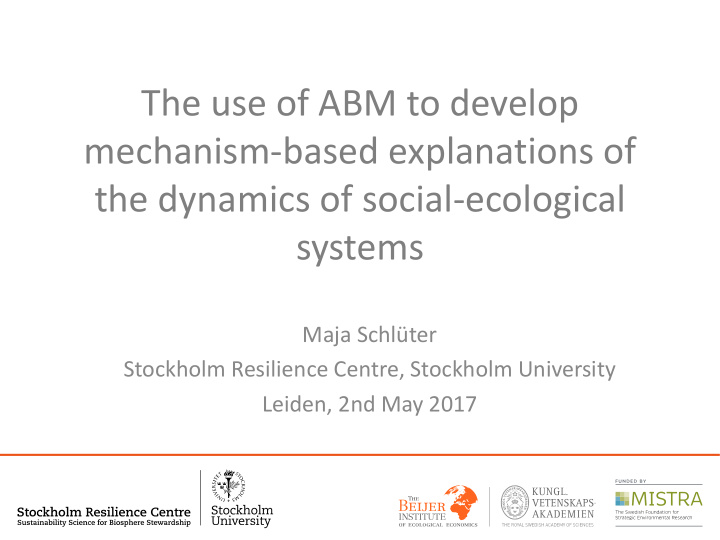



The use of ABM to develop mechanism-based explanations of the dynamics of social-ecological systems Maja Schlüter Stockholm Resilience Centre, Stockholm University Leiden, 2nd May 2017
How agent-based modelling can help us to • move from description to explanation Conceptual Models (from what to how) • Integrate knowledge from different x disciplines • build understanding that is context sensitive but not context dependent Rich Case Studies • develop middle-range theory (i.e. theories that apply to concrete phenomena in a subset of cases)
Social-ecological Systems Research on social-ecological systems • Sustainable resource use • Regime shifts • Transformations to sustainability • Understanding of important social-ecological processes and phenomena How to capture the interdependence between humans and the ecosystems they affect and depend on? Image: Edward Burtynsky
are complex adaptive systems SES phenomena emerge from local social-ecological interactions and adaptations How to analyse macro micro to macro and macro to micro micro interactions? Openabm.org
Emergent SES phenomena Common-pool resource Regime shifts governance Traps What are key social-ecological interactions?
The Institutional Analysis and Development Framework (Ostrom 1990) Structural
An action situation based framework Emergent Macro Phenomenon Social AS Social – ecological AS Ecological AS Micro A A EC EC A EC Social and ecological conditions
Patterns of self-governance in small-scale fisheries With Emilie Lindkvist (SRC) & Xavier Basurto (Duke University)
Self-governance of small-scale fisheries • Small-scale fisheries important for global food production but often neglected by governments as minor policy field • Cooperative and non-cooperative forms of self governance (Cooperatives (co-ops) and patron-client relationships (PCs)) • PCs increasingly dominant but co-ops more desirable What explains the dominance of PCs and under which conditions are cooperatives more successful?
Key micro-level interactions • A-E: fishing; A-A: selecting fishers, lending, returning catch/cheating, exiting; E-E: reproduction • Cheating as function of reliability and loyalty • Loyalty changes through social interactions (slower in coops) Model based on synthesis of qualitative data, field observations and literature
Coops more sensitive to unreliable fishers Mean reliability Variance of reliability Reliability in organization
Coops dominate in homogenous communities with history of working together Coops can better cope with seasonal variability
Micro- to meso- to macro-level interactions affecting the emergence of co-ops and PCs • Reinforcing feedback between loyalty and cheating (more loyalty -> less cheating -> more loyalty) stabilizes organization • Establishment dependent on combination of initial group composition, initial loyalty, number of other organzations, state of the fish population • PCs can better cope with high heterogeneity because of more flexible membership rules • Coops once established are more robust to fluctuations in fish stock (because of formal membership)
Mechanism-based explanations Macro-level A mechanism refers to the entities of a causal process that produces the effect of interest (not necessarily deterministic) Micro-level Hedström & Swedberg 1998 Feedbacks (e.g. social norms, resource degradation) Micro-level interactions (e.g. patron-client relationships)
Action-formation mechanisms – The MoHuB framework Schlüter et al. 2017
Summary ABM are useful tool to • Identify and test mechanisms underlying SES phenomena • Integrate knowledge across domains in co-development processes • Identify conditions under which mechanisms hold But multiple challenges such as • How to identify mechanisms in the models • Representing human decision making • Developing empirical synthesis and hypothesis • Linking processes across different scales and levels of aggregation
THANK YOU! maja.schlueter@su.se www.seslink.org
Recommend
More recommend